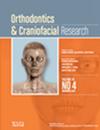Ability of Orthodontists to Detect, Interpret and Propose Management Strategies for Incidental Findings on Pre-Treatment Panoramic Radiographs
Abstract
Objectives
Radiographs are routinely acquired for orthodontic evaluation, and incidental findings (IFs) may be detected early as part of this routine care. This study aimed to assess the prevalence of IFs on panoramic radiographs taken for orthodontic assessment and evaluate the ability of orthodontists to detect, interpret and recommend management for IFs.
Materials and Methods
A retrospective analysis of 1756 patients aged 7–21 with a panoramic image taken for orthodontic evaluation was performed. IFs were categorised by anatomic region and assigned a significance level based on a custom-made risk assessment tool. Twelve selected images were evaluated by 30 orthodontists via a standardised online survey. Participants were tasked with reviewing each image, providing a radiological interpretation, and indicating whether a referral would be needed prior to commencing orthodontic treatment. The responses were scored against those of an expert oral and maxillofacial radiologist (OMFR). Inter-observer agreement was evaluated by computing the Cohen's K.
Results
The prevalence of IFs was 30.8%. The most common findings were impacted teeth (17.7%), hypodontia (14.9%) and dense bone islands (14.7%). After applying the risk assessment tool, 35% of the findings were considered highly significant. The overall agreement between the orthodontists and OMFR was k = 0.32 (95% CI = 0.30–0.34). The agreement for location was 0.52 (95% CI = 0.47–0.58), whereas it was k = 0.45 (95% CI = 0.40–0.50) for diagnosis and k = 0.19 (95% CI = 0.13–0.24) for referral need.
Conclusions
Orthodontists may benefit from additional education and training focused on interpretation and management of IFs on panoramic radiographs.

 求助内容:
求助内容: 应助结果提醒方式:
应助结果提醒方式:


